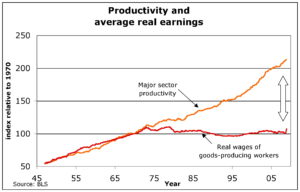This graph rolled across my twitter feed this morning. I can’t find the original tweet, but I borrowed the following version from an old post at The Current Moment.
There are a number of competing explanations for this divergence. Some are quite straightforward, such as absence of health care benefits in the calculation of wages. Some are more esoteric, such as failure to distinguish between PCE and consumer price inflation. Yet, on some level those are just distractions to a core fact: somewhere between the late 1960s and the early 1970s the U.S. economy changed in a fundamental way.
The most compelling explanations for me have centered around Tyler Cowen’s story of a Great Stagnation. In the wake of the recent debate around market power and concentration, I am toying with a new hypothesis. Call it for now, the Great Variation.
The gist is this. In many ways, as contemporary observers noted, the U.S. crossed a transformational threshold in the 1960s. For the first time, material deprivation was something almost alien to a significant subset of the population. The desire for something more, something deeper than the satisfaction of biological needs roared forth. I think we saw that in the counter-culture and political upheaval of the day.
Yet, this outbreak of mass affluence I suspect led to something else: the desire for individualized consumption. What dinner set defines me as person, if you will. The response to this question was a massive increase in product variation. This variation lead to fixed costs, associated markups, and stagnate wages for core production workers.
The thing is, it would have also mechanically led to lower measured productivity growth and the appearance of stagnation. I am not sure how deep the rabbit hole goes, but I am keen to find out.
